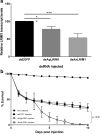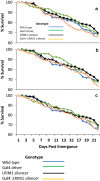Transient knockdown of Anopheles stephensi LRIM1 using RNAi increases Plasmodium falciparum sporozoite salivary gland infections
- PMID: 34174879
- PMCID: PMC8235909
- DOI: 10.1186/s12936-021-03818-8
Transient knockdown of Anopheles stephensi LRIM1 using RNAi increases Plasmodium falciparum sporozoite salivary gland infections
Abstract
Background: Plasmodium falciparum (Pf) sporozoites (PfSPZ) can be administered as a highly protective vaccine conferring the highest protection seen to date. Sanaria® PfSPZ vaccines are produced using aseptically reared Anopheles stephensi mosquitoes. The bionomics of sporogonic development of P. falciparum in A. stephensi to fully mature salivary gland PfSPZ is thought to be modulated by several components of the mosquito innate immune system. In order to increase salivary gland PfSPZ infections in A. stephensi and thereby increase vaccine production efficiency, a gene knock down approach was used to investigate the activity of the immune deficiency (IMD) signaling pathway downstream effector leucine-rich repeat immune molecule 1 (LRIM1), an antagonist to Plasmodium development.
Methods: Expression of LRIM1 in A. stephensi was reduced following injection of double stranded (ds) RNA into mosquitoes. By combining the Gal4/UAS bipartite system with in vivo expression of short hairpin (sh) RNA coding for LRIM1 reduced expression of LRIM1 was targeted in the midgut, fat body, and salivary glands. RT-qPCR was used to demonstrate fold-changes in gene expression in three transgenic crosses and the effects on P. falciparum infections determined in mosquitoes showing the greatest reduction in LRIM1 expression.
Results: LRIM1 expression could be reduced, but not completely silenced, by expression of LRIM1 dsRNA. Infections of P. falciparum oocysts and PfSPZ were consistently and significantly higher in transgenic mosquitoes than wild type controls, with increases in PfSPZ ranging from 2.5- to tenfold.
Conclusions: Plasmodium falciparum infections in A. stephensi can be increased following reduced expression of LRIM1. These data provide the springboard for more precise knockout of LRIM1 for the eventual incorporation of immune-compromised A. stephensi into manufacturing of Sanaria's PfSPZ products.
Keywords: Anopheles stephensi; Gene silencing; Immune system; Mosquito; Oocyst; PfSPZ vaccine; Plasmodium falciparum; Sporozoite.
Conflict of interest statement
PFB, AGE, TL, SC, BKLS and SLH are employees of and shareholders (BKLS, SLH) in Sanaria Inc., manufacturers of PfSPZ vaccines.
Figures








Similar articles
-
Knockout of Anopheles stephensi immune gene LRIM1 by CRISPR-Cas9 reveals its unexpected role in reproduction and vector competence.PLoS Pathog. 2021 Nov 16;17(11):e1009770. doi: 10.1371/journal.ppat.1009770. eCollection 2021 Nov. PLoS Pathog. 2021. PMID: 34784388 Free PMC article.
-
Is Saglin a mosquito salivary gland receptor for Plasmodium falciparum?Malar J. 2019 Jan 3;18(1):2. doi: 10.1186/s12936-018-2634-5. Malar J. 2019. PMID: 30602380 Free PMC article.
-
Chimeric Plasmodium falciparum parasites expressing Plasmodium vivax circumsporozoite protein fail to produce salivary gland sporozoites.Malar J. 2018 Aug 9;17(1):288. doi: 10.1186/s12936-018-2431-1. Malar J. 2018. PMID: 30092798 Free PMC article.
-
Comparative susceptibility of three species of Anopheles from Belize, Central America, to Plasmodium falciparum (NF-54).J Am Mosq Control Assoc. 2005 Sep;21(3):279-90. doi: 10.2987/8756-971X(2005)21[279:CSOTSO]2.0.CO;2. J Am Mosq Control Assoc. 2005. PMID: 16252518
-
Dihydroartemisinin suppresses the susceptibility of Anopheles stephensi to Plasmodium yoelii by activating the Toll signaling pathway.Parasit Vectors. 2024 Oct 4;17(1):414. doi: 10.1186/s13071-024-06497-x. Parasit Vectors. 2024. PMID: 39363238 Free PMC article.
Cited by
-
A recombinant Aspergillus oryzae fungus transmitted from larvae to adults of Anopheles stephensi mosquitoes inhibits malaria parasite oocyst development.Sci Rep. 2023 Jul 27;13(1):12177. doi: 10.1038/s41598-023-38654-0. Sci Rep. 2023. PMID: 37500682 Free PMC article.
-
Mosquito midgut stem cell cellular defense response limits Plasmodium parasite infection.Nat Commun. 2024 Feb 16;15(1):1422. doi: 10.1038/s41467-024-45550-2. Nat Commun. 2024. PMID: 38365823 Free PMC article.
-
Novel systems to study vector-pathogen interactions in malaria.Front Cell Infect Microbiol. 2023 May 26;13:1146030. doi: 10.3389/fcimb.2023.1146030. eCollection 2023. Front Cell Infect Microbiol. 2023. PMID: 37305421 Free PMC article. Review.
-
Combination of computational techniques and RNAi reveal targets in Anopheles gambiae for malaria vector control.PLoS One. 2024 Jul 5;19(7):e0305207. doi: 10.1371/journal.pone.0305207. eCollection 2024. PLoS One. 2024. PMID: 38968330 Free PMC article.
-
Cryopreservation of Anopheles stephensi embryos.Sci Rep. 2022 Jan 7;12(1):43. doi: 10.1038/s41598-021-04113-x. Sci Rep. 2022. PMID: 34997079 Free PMC article.
References
-
- WHO . World malaria report 2020. Geneva: World Health Organization; 2020.
-
- Billingsley PF, Maas CD, Olotu A, Schwabe C, García GA, Rivas MR, et al. The Equatoguinean malaria vaccine initiative: from the launching of a clinical research platform to malaria elimination planning in central west Africa. Am J Trop Med Hyg. 2020;103:947–954. doi: 10.4269/ajtmh.19-0966. - DOI - PMC - PubMed
-
- Weiss DJ, Bertozzi-Villa A, Rumisha SF, Amratia P, Arambepola R, Battle KE, et al. Indirect effects of the Covid-19 pandemic on malaria intervention coverage, morbidity, and mortality in Africa: a geospatial modelling analysis. Lancet Infect Dis. 2020;21:59–69. doi: 10.1016/S1473-3099(20)30700-3. - DOI - PMC - PubMed
-
- Sissoko MS, Healy SA, Katile A, Omaswa F, Zaidi I, Gabriel EE, et al. Safety and efficacy of PfSPZ vaccine against Plasmodium falciparum via direct venous inoculation in healthy malaria-exposed adults in Mali: a randomised, double-blind phase 1 trial. Lancet Infect Dis. 2017;17:498–509. doi: 10.1016/S1473-3099(17)30104-4. - DOI - PMC - PubMed
MeSH terms
Substances
Grants and funding
LinkOut - more resources
Full Text Sources

